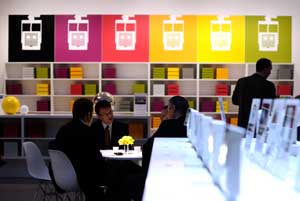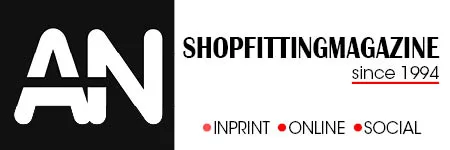
E-commerce competitors challenge brick-and-mortar retailers. Being able to create a special ambiance is one of the trump cards the latter can play to score points.
A trend toward individuality in shop design and a desire to surprise customers again and again fuel the climate of innovation currently developing around shopfitting and stand construction materials.
Be it paintable genuine metal, veneer made from banana trees, photo-luminescent granulate or bendable and rollable plywood – nothing seems impossible anymore.

“One clear trend of recent years continues today and is steadily growing stronger: the perpetual increase in available materials,” states the “Materialreport 2013/14,” the annual materials update issued by the Stuttgart agency Raumprobe, which specialises in this field. That’s why it’s so crucial for retailers, designers, shopfitters and stand builders to obtain a comprehensive overview of the new possibilities.
EuroShop, the world’s largest trade fair for retail investment taking place at the Düsseldorf exhibition centre from 16 to 20 February 2014, is the ideal platform for doing just that. The areas EuroConcept and EuroExpo in Halls 5 and 10 to 15 provide an overview of the entire spectrum. Expect nothing less from products on exhibit than total optical and/or tactile enjoyment, often with additional functional benefits which increasingly also means conservation of resources.
Genuine materials and nature-identical surfaces
“We see two trends converging right now in the retail segment: one toward natural materials and another toward individualised designs. That’s why we expect an abundance of natural and substantial materials – rustic wood, for example, but also stone or concrete. Furthermore, the most convincing materials will be the ones that have some distinct feature enabling the creation of a customised appearance,” says Klaus Monhoff, Director for Design and Décor Management at Egger Group in St. Johann in Tyrol, Austria, capturing the prevailing opinion among industry experts. “We do justice to these trends by employing, among other things, new digital-print motives mostly highlighting material characteristics and natural features.” The same is true for acoustic boards in warm unicolour tones and wood, as well as compact boards with indentions on the surface.”
“Materials should be extraordinary, trendy, durable and at the same time low-maintenance and multifunctional,” says Nina Freund from the company Freund – Material für Ideen, recounting the demands of the present era. The company caused quite a sensation at the last EuroShop with its “Wonderwall,” a vertical green space. Indoor greening has taken the world by storm ever since; meanwhile, the Berlin company even distributes moss labyrinths as acoustic ceiling sails. “Our product line contains a variety of natural materials, starting with the three different moss walls to leather, wood and cork walls and all the way through to milled-out panels and water walls,” Nina Freund says. Kreos from Bad Wurzach, a distributor specialising in innovative board and surface materials for high-end interior design applications, also offers moss boards – in eleven colours! Growing these mosses in Scandinavia takes quite a bit of effort and expense.
They live solely on the humidity in the air, thereby contributing to an improved indoor climate – visually, too. Also found among the new offerings in the Kreos range is organic composite board with hay, barley, autumn foliage and other surfaces. “The nature theme is the overarching trend,” agrees David Segger, who is responsible for sales and marketing at Kreos, and Nicole Lepper, member of the Management Board at Moysig Retail Design in Herford, explains the development toward “real” materials as follows: “A yearning for authenticity is growing as a counterweight to our technology-dominated era and the artificial world of the Internet.”
Among those authentic materials are (scrap) wood, metal, stone and leather. Based on its database access records, Raumprobe determined this year’s Top Ten most-requested material categories. They are: wood (20%), plastics (19%), textiles (12%), coating and metal (11% each), glass (8%), concrete (6%), stone (5%), ceramics (3%), and sandwich structures and paper (2% each).
Four major trends in Europe
The carpet fibre brand Antron, which is part of the Invista corporation, conducts regular trend studies surveying both floor coverings and home furnishings. They’ve identified four major trends in Europe for 2014/15: “Natural Minimalism” includes natural materials, clear, reduced forms, fine structures and surfaces, soft, powdery colours and the blue palette centred on indigo.
“Global Patchwork” describes the fusion of distinct cultural influences including ethnic, Native American and African styles, the modern interpretation of tradition, the mix of décors, materials, crafts and industrial manufacturing, as well as colourful, gleaming nuances. “Sense of Touch” includes 3D-effects, optical illusions, multi-layered and generally multifarious structures, materials with peaks and valleys, as well as geometrical patterns and shapes.
The dominant colours here are black, grey and white; a shot of neon delivers the contrast. And last, but not least, “Recreate Century” signifies the resurgence of historical elements. Antiques are central, as is opulence in the form of flamboyant patterns, for example. The tone is set by high-gloss, metallic surfaces and silver, gold and copper hues.
Nothing speaks against combining two or more trends in one product. Take, for example, Homapal from Herzberg in the Harz Mountains, a company that calls itself a specialist for “exceptional surfaces” and “boards that have it going on.” With “Lava” and “Volcano” they’ve just launched high-gloss décors reminiscent of boiling metal. The amorphous structures, which are transferred to anodised aluminium surfaces through a special embossment process, create atmosphere – especially when combined with light (another trend topic). “Combining tried and tested materials with innovations also results in wonderful contrasts and illustrates society’s multifaceted nature. Our natural materials work great in conjunction with widely used construction elements such as concrete and glass. It’s en vogue to play with contrasts and allow combinations of contradictory styles,” points out Nina Freund of Freund GmbH. “Viewing habits can also be broken by, for example, installing traditional floor coverings on the ceiling or by using the same parquet for floor, wall and ceiling,” says Karl Schwitzke, Managing Partner of Düsseldorf-based design company Schwitzke & Partner, promoting such off-the-wall ideas.
Using materials as language
EuroShop doesn’t just show a multitude of options and recent developments. Exhibiting planners, shopfitters and stand builders support retailers in finding the right materials for their needs. “What do you want to express? Materials should be used as language, underscoring the company philosophy,” Karl Schwitzke explains, pointing out the importance of understanding the connotations of materials and colours, which may be vastly different internationally, and of purposefully choosing or avoiding them. When Germans see beech wood, it will oftentimes reminds them of their teenage bedrooms because of their specific life experience.
Seeing spruce most likely will bring up thoughts of Ikea. And marble elicits a natural but currently not exactly positive association with banks. “Fitting the Deutsche Bank concept stores on the Unter den Linden boulevard in Berlin, we consciously avoided any material that might have appeared ritzy,” Schwitzke recalls. Over the course of several years, Kraiss – stores – shops – systems from Bad Urach has developed a database populated with over 3,200 items offering psychological insights. For example, if a retailer wants to position himself as “family friendly,” rather than using his gut instinct he can refer to the system to obtain well-founded information about the materials, surfaces, shapes and colours that perfectly reflect this value. Aggregating all entered terms, the database generates explicit design recommendations.
Karl Schwitzke knows this much: “Oiled oak is the favourite flooring material of Germans, while stone floors are a must in Arabic countries. Carpet and wood don’t work there at all; the floor has to appear cool.” With this, he alludes to global differences. Schwitzke & Partner works globally and employs people from 23 nations to ensure their designs never miss the mark. Hannes Bäuerle, the owner of Raumprobe, has come to the conclusion that “even within Germany there are noticeable differences from north to south when it comes to preferred materials.”
Sustainability – an important issue
Even though different regions assign varying degrees of importance to it, the sustainability issue is on the rise everywhere and will play a significant role at EuroShop, too. Key words to be mentioned here are deployment of renewable resources and recyclates, foregoing substances harmful to human health and the environment, and better resource efficiency. It’s a balancing act for many exhibitors. “The issue turns out to be quite complex once you start seriously pursuing it,” says Karl Schwitzke. It drives up prices. “But spending more money is out of the question for most retailers.” So for sure the topic will once again be hotly debated at EuroShop. Says Hannes Bäuerle: “I think sustainability is still not being accorded the proper amount of importance. There’s still enormous potential.”
EuroShop 2014 is open to trade visitors from Sunday, 16 February 2014, to Thursday, 20 February 2014, daily from 10.00 am to 6.00 pm. 1-day admission tickets cost EUR 60.- (EUR 42.- when purchased in advance online), 2-day tickets are EUR 80.- (EUR 60.- when purchased online) and event passes are EUR 135.- (EUR 115.- when purchased online). Students and trainees pay EUR 20.-. Admission tickets include a free return trip to EuroShop on public transport marked VRR (Verkehrsverbund-Rhein-Ruhr).


